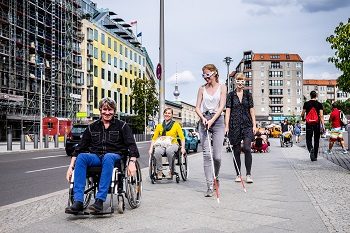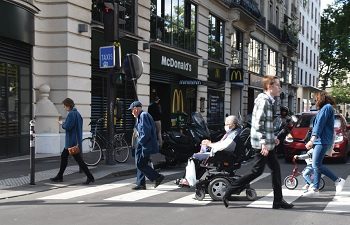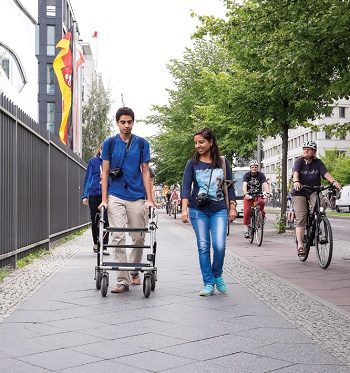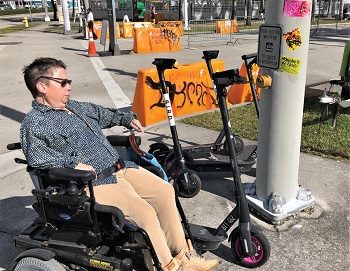Ensuring the 15-Minute City Serves All
The 15-minute city/neighborhood, at face value, sounds as inclusive as any urban-planning concept ever introduced — jobs, housing, health care, groceries, shopping, education, parks, services and more within a 15-minute walk or bike ride. Fixed-route transit is plentiful, so no one has to own/maintain a car.
A compact, mixed-use area should have jobs to uplift low-income folks and a city designed with a diversity of services should address the needs of diverse people — those marginalized by color, gender, physical ability, etc.
But the sad fact is, unlike a big chunk of the post-World War II 20th century — when cities were affordable and wealth was clustered in suburban homes — amenity and activity-rich city centers are increasingly affordable only to the upper class.
Converting older office, with public support, into affordable housing is a must.
Ownership is out of reach for most, rent is staggeringly high and the point of entry for commercial space prevents many mom and pops shops from opening in the urban core.
So how does Charlotte, N.C., or Baton Rouge, La., let alone Paris or New York, plan for affordability, accessibility and equity — especially when many have been hit hard or crushed by pandemic economics?
Professor/urbanist/writer Richard Florida addressed many of these issues in his 2017 book, “The New Urban Crisis: How Our Cities Are Increasing Inequality, Deepening Segregation, and Failing the Middle Class — and What We Can Do About It.”
“Unaffordability and inequity have long been a problem in the superstar cities — New York, San Francisco, Boston, [Washington] D.C. If you look at the prices of homes — up double digits — that new urban crisis is moving to Miami, Dallas, Nashville and to the second and third tier cities,” said Florida, professor at the University of Toronto’s School of Cities and Rotman School of Management, co-founder of CityLab, and founder of the Creative Class Group.
Florida fears the pandemic will increase the divide, if government doesn’t take action. He said the pandemic already has accelerated inequity — even in terms of crucial healthcare, where Black and Latino Americans have higher COVID rates and less access to testing or vaccines.
He also noted the chasm that allows the wealthy to work from home in safety and shelter, while low-income service workers have had to face exposure at jobs that interact with the public.
Florida supports compact, vibrant, mixed-use, transit-served development. But he said unless government intervenes, only one third of the population will be able to afford to live in the 15-minute neighborhood. “We know about food deserts, lack of broadband access — these divides will accentuate, unless we do something as a society,” he said.
Florida said there have been two “rays of silver lining” the past year: a workable COVID vaccine available within a year of the outbreak and the outpouring of attention focused on a more equitable society — that grew under the Black Lives Matter movement. He believes the new administration will help cities build more transit, bike lanes, housing and other infrastructure aimed at improving equity.
Florida said local governments will have to create more regional partnerships, to solve issues that extend beyond city or county boundaries. Even the trend of more permanent work from home, resulting in office vacancy, can create opportunity.
“In urban centers, residential is the highest and best use,” he said. “Converting older office, with public support, into affordable housing is a must. As we rebuild office-tower-dominated central business districts into more 15-minute neighborhoods, we must ensure they have workforce housing. There is a model for this: New York City has inclusive zoning; when a developer wants more height etc., they have to include 25 percent more affordable housing.”
Florida said the decline in retail creates an opportunity in the suburbs, especially for malls and office parks near major highways or on main bus routes. He said increased density and affordable housing could turn these huge land masses into livable areas with co-working space and mixed-use development.
“Zoning and building regulations are a century old,’ he said, noting a major overhaul to promote equity and inclusion is long overdue. “[These were] very necessary during factories, when housing needed to be separated from a polluting environment. But that set of codes is no longer adequate to deal with a clustered, knowledge-based environment.”
For more than half a century, zoning codes have been used to exclude density and affordable housing from the suburbs, Florida said. He encourages public-private partnerships to quash antiquated, exclusionary codes and to replace them with denser, more affordable housing.
“Virginia and Maryland — the places where people who work in D.C. live — never had density and no one thought they would. But over the past few decades, they have added density, offices, groceries, amenities and transit,” he said, pointing to those bedroom communities turned into more inclusive cities as an example to duplicate. “They have allowed taller, denser apartment buildings and look where Amazon HQ2 is going — right in this area [in Arlington].”
The AARP, aware that many people outlive the ability to drive a car to meet their needs and that living in isolation has negative mental and physical health impacts, has become a leading advocate for livable communities in a denser, urban setting.
Our country is aging. By 2034, there will be more people over 65 than under age 18.
“Our country is aging. By 2034, there will be more people over 65 than under age 18 for the first time ever,” said Danielle Arigoni, AARP director of Livable Communities. “That’s a significant demographic. It calls out to ask the question, are we ready? The answer is most communities are not ready.”
“Most are not designing for older adults,” she continued, noting increased rent burden, a paucity of public transit and the lack of housing accessible to people with disabilities as major issues. There are a number of people who want to stay in their communities, but don’t feel they are able to.”
Arigoni said many people want to walk to nearby conveniences, but most streets are too dangerous to cross. She said transit can be a lifeline to many, but most systems are not designed for older people. Subway and elevated train systems in New York, Chicago and other cities were built without elevators and even with retrofits, only a fraction of stations are accessible to people who use wheelchairs for mobility or are not capable of walking hundreds of stairs to a boarding platform.
“Older adults don’t use public spaces. They are 20 percent of the population, but participate in only 4 percent of park use,” Arigoni said, citing a RAND Corporation study. “We must apply an age-friendly lens to how we design housing, transportation and communities.”
The age-friendly strategies are the same as the 15-minute city, she said.
We must apply an age-friendly lens to how we design housing, transportation and communities.
“Age-friendly is very inclusive. It also is good for young people and people with disabilities of all ages,” Arigoni said, noting that AARP encourages people to advocate for a built environment that makes them comfortable and allows them to safely move about.
To encourage aging in place and accessibility, AARP published the “HomeFit Guide” featuring smart ways to make a home comfortable, safe and a great fit for older adults — and people of all ages.
Victor Santiago Pineda — who has a Ph.D. in urban planning and uses a wheelchair for mobility — is a speaker, advocate, philanthropist and senior research fellow at the Haas Institute for Fair and Inclusive Society at Berkeley.

“We want more local-based services, more cities with mobility options — it has always been important, but COVID-19 has made it even more urgent,” he said. “We must look at inclusion. It will define the future of humanity.”
Pineda shared from a 2020 article on his work in the Haas Berkeley online newsletter:
“I have five criteria for making cities accessible. The first is about laws at every level of government and what they say about building accessibility into city services or the technologies that cities use. The second is about leadership: ‘Are city leaders talking about these issues and using their budgets to identify barriers and remove them?’” Pineda said in the article.
“The third area, which is critical, is about institutional capacity. You need a cross-agency approach. For example, do all 56 agencies in New York City’s government understand what digital accessibility is?” he asked. “My fourth criterion is about participation and representation. Are you only talking to people who use wheelchairs about how to build an accessible smart city, or are you also asking people with dementia?”
Now, because of COVID-19, many more people are experiencing how it feels to have barriers and restrictions placed on how they access public spaces and services.
Finally, we need to change attitudes. We continue to have a divergent set of implicit biases around race, gender, and something called ‘ableism.’ We’ve inherited a public infrastructure that is ableist by design—meaning that, even with the ADA, it still gives preferences to people who can open doors, climb stairs, run around,” Pineda said in the newsletter. “Now, because of COVID-19, many more people are experiencing how it feels to have barriers and restrictions placed on how they access public spaces and services, so there is a greater appreciation for the challenges persons with disabilities have long experienced.”
Tamika Butler — African American, Lesbian rights advocate, attorney and nonprofit manager — is founder and principal of the transportation and urban planning firm, Tamika L. Butler Consulting.
For me, the approach should be ‘how are we able to do this in the most intersectional way?’” Butler said. “Who’s able to talk about race, gender, trans people, undocumented immigrants — and how transportation and urban planning must consider a project’s impact through many lenses.”
Butler works on walking, biking and transportation projects, plus she advises nonprofits. All of the work is done with clients that buy into the idea of equity, of giving a voice to those who have been ignored in conventional planning processes.
“We plan spaces, we like to think we’re planning for every man or every woman — but we’re doing everything based on abled-bodied white folks. They are not built in a way that others, people that are different, can relate to or use them,” she said, noting she is proud of her diverse background and hopes the public realm can be designed for all.
Butler said intersectional planning is not simply about equity for marginalized people, it also implies connectivity between related issues that must be considered before a viable, sustainable decision can be made.
“Transportation and climate crisis are intrinsically linked,” she said. “Everyone doesn’t experience space the same way, so we have to be thoughtful. Public works departments rushed to create outdoor space in response to the pandemic, but they didn’t engage diverse views. No one asked `If you use a wheelchair, is that sidewalk dining accessible for you?’”
Whether it is called the 15-minute neighborhood or any other term for a neighborhood with diverse offerings, it must be designed with inclusion in mind, Butler emphasized. She noted few cities seek input from the LGBTQ community.
“If you are not bringing in that perspective, you’re missing it,” she said. Talk to people, have a team full of queer folks talk about their experience. How does it feel to be trans, to feel different? How can you create a space where people can be themselves?”
Heidi Johnson-Wright, a law school graduate and Americans with Disabilities Act (ADA) compliance professional, has used a power wheelchair for mobility for 35 years.
“Many people with disabilities would welcome the benefits of the 15-minute neighborhood because of the reduction of car dependence,” she said. “Some cannot or do not want to drive. Many who can drive cannot afford to buy and insure a vehicle.”
People with disabilities have high rates of unemployment and are more likely to live in poverty than any other minority group. Those who survive on a monthly government (SSI) benefits check receive less than $800, which is all they have for rent, food, transportation, etc.
Transportation remains a challenge for people with disabilities, especially for people who use mobility devices such as power wheelchairs and scooters.
“Unfortunately, transportation remains a challenge for people with disabilities, especially for people who use mobility devices such as power wheelchairs and scooters. When transit is well maintained, wheelers can access fixed-route buses and trains, as well as paratransit,” Johnson-Wright noted.
Getting to transit requires smooth sidewalks with a clear path of travel — free of obstructions such as signs, utility poles and, street furniture — at least 36 inches wide with curb ramps at every corner.
“Another challenge is the recent proliferation of alternative modes of travel, often billed as ‘first mile, last mile’ solutions — such as rentable bikes and motorized scooters,” Johnson-Wright said. “None of these, including rideshare and car share, is accessible to wheelchair users. All of this results in social isolation and a serious lack of mobility for disabled people.”
The 15-minute city cannot be inclusive without a major increase in public spending to boost sidewalk and transit access. Despite the ADA, which turned 30 last year, requiring readily achi evable barrier removal since 1992, many buildings have barriers that discourage or out-right prevent disabled people from patronizing local businesses within walking/rolling distance of their homes. These include steps at entrances, narrow doorways, too-high counters and inaccessible restrooms.
evable barrier removal since 1992, many buildings have barriers that discourage or out-right prevent disabled people from patronizing local businesses within walking/rolling distance of their homes. These include steps at entrances, narrow doorways, too-high counters and inaccessible restrooms.
Johnson-Wright cited Cambridge, Massachusetts’ Storefront Improvement Program as a model for a public-private partnership resulting in access for all.
“The Program improves the physical appearance of independent businesses and enhances access,” she said of the resource available to property owners and tenants. “Reimbursement grants range from $2,500 to $35,000, based on the scope of work. For barrier removal, there’s a 90-percent-matching grant up to $20,000 for ADA improvements to entrances, including ramps, lifts, doors hardware and automatic openers, accessible parking and signage.”
Amanda O’Rourke is executive director at 8 80 Cities, a Toronto-based planning firm dedicated to making cities accessible and livable to those ages 8 to 80. “The 15-minute city vision is aligned with our values. It creates cities that are more inclusive,” she said. “The vision must not be just about the physical built environment, but also about the social environment — communities participating and being part of the process.”
“Theoretically, it is very much about creating equitable places,” she added, saying the concept must correct the errors of the last century of planning — which fostered disparity, segregation and worse. “The details really matter. We must really design cites that promote health and well-being for all.”
O’Rourke said the 15-minute neighborhood/city cannot be a vision in a report, it has to be a shift of spending. She said a city budget is a reflection of true priorities — is the spending on infrastructure for people, or cars?
“COVID has definitely helped people understand the importance of their local neighborhood more than ever,” she said. “Why the interest in 15-minute neighborhood has sparked again? If they are able to access all their goods and services within a 15-minute walk, it’s so much more convenient in the pandemic. And people are seeing how inconvenient a neighborhood is where needs cannot be met on foot.”
O’Rourke said to keep essential workers on the job, cities need better transit. She said the pandemic has underscored the need for zoning that facilitates a better built and social environment.
“Communities disproportionately impacted by COVID-19, are also underserved by park space, walkability, traffic safety,” she said. “Communities need to define their own priorities instead of top-down planning. Communities need to drive the fine grain development, amenities and ensure different levels of affordability.”
Cristina Garrido — director of Innovation for CitiesToBe — said while Barcelona, New York and Paris are trying to address affordable housing, every city must focus on this issue.
“Access to housing was already an increasing and unresolved problem in big cities,” she said of the necessity of affordable housing in the 15-minute city. “While urban central areas are gentrifying and real estate has become a luxury good, there are millions of people living in poor housing conditions and informal settlements around the world. So, this pandemic has only made it clearer that having a decent house to live in is a human right we should all have.”
Source: “Inclusion, Equity and Accessibility“


